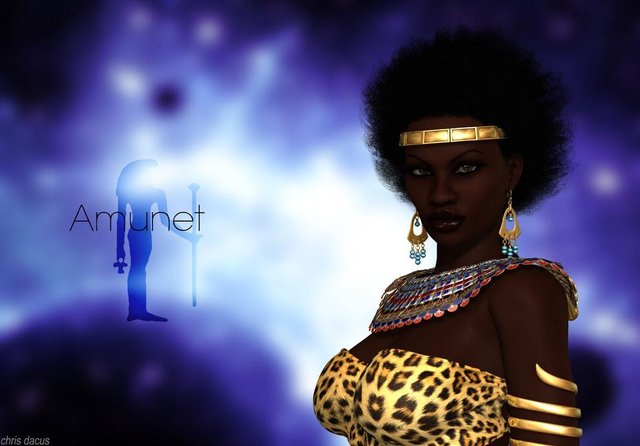
In Egyptian mythology, Amunet, although predominantly known as the goddess of the air and invisibility, has changed in personification over the duration of the dynasties of Egypt. She is believed to be the female form of the greater god Amun and is one of the eight featured deities in the Ogdoad (consisting of four pairs where the woman’s name is a derivative of that of the husband). Like most of the Ogdoad goddesses, she takes the form of a woman with head of an Egyptian cobra, or simply just a regular snake. Her name also comes in several other variations including Amonet, Amaunet, Imentet, Imentit, Amentet, Amentit and Ament. Her name means a female who is hidden and her powers are connected to the words silence, stillness, mystery and obscurity.
According to some myths Amunet was the daughter of Horus and Hathor. She was also sometimes merged with Hathor, Isis and Neith, Mut, and Nut.
As the goddess of the air, she is depicted as a winged goddess or a woman with an ostrich feather or a hawk on her head. In hieroglyphs, she is represented as a woman with the sign of the West (a semi circle on top of one long and one short pole), thus she has been given the title “She of the West”. In Ancient Egypt, the West is the where the dead enter the underworld and Amunet is believed to be as the goddess who welcomes their entrance into the Kingdom of Osiris.
Over the years, she became increasingly associated with Iusaaset, a shadow of Atum. This association made her the mother of all creation who owns the tree from which life emerged and returns (the most ancient acacia tree believed to be found in Heliopolis, the city where all deities were born). She is sometimes shown as a woman with a scepter and the ankh of life in her hand.
Amunet started as one of the androgynous goddesses capable of giving birth without a male to procreate (like snakes whom ancient Egyptians believed to be all females). Because of this, she acquired the title “the mother who is a father”. She likewise acquired a familiar association (even leading to as role as lesbian consort in some stories) with the moon Iah making her a goddess of the tomb, sarcophagus, and coffins.
The cult association with the goddess Neith led to the building of an imposing statue and temple of this goddess in Karnak in the time of Tutankhamun. She was depicted as woman wearing a red crown and carrying a staff made of papyrus. By this time (around the twelfth dynasty), she was already a distinct female goddess and known consort of the god Amun. However, Mut eclipsed her role as the main consort of Amun. Despite that, she remained of relative importance as a protector of the pharaoh especially in the region of Thebes.
cool :)
Downvoting a post can decrease pending rewards and make it less visible. Common reasons:
Submit
very interesting!
Downvoting a post can decrease pending rewards and make it less visible. Common reasons:
Submit
Hi! I am a robot. I just upvoted you! I found similar content that readers might be interested in:
http://egyptian-gods.org/egyptian-gods-amunet/
Downvoting a post can decrease pending rewards and make it less visible. Common reasons:
Submit
Congratulations @emkhet! You have received a personal award!
Click on the badge to view your Board of Honor.
Do not miss the last post from @steemitboard:
Downvoting a post can decrease pending rewards and make it less visible. Common reasons:
Submit
Congratulations @emkhet! You received a personal award!
You can view your badges on your Steem Board and compare to others on the Steem Ranking
Vote for @Steemitboard as a witness to get one more award and increased upvotes!
Downvoting a post can decrease pending rewards and make it less visible. Common reasons:
Submit